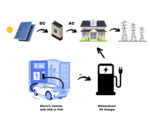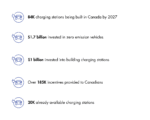Bidirectional charging makes the power grid more efficient and greener. This emerging technology allows consumers to keep their electricity, internet, fridges and other appliances running during emergencies, by eliminating the impact of power outages.
Bidirectional charging also comes with the capability to store energy in electric vehicles, powering grids and homes, which extends beyond the idea of simply charging cars.
While those capabilities of bidirectional charging might sound exciting, with more companies investing in EV charging manufacturers, it only makes sense to look at the whole process closer and understand some basics. Today we are discussing whether bidirectional charging will transform the future of Canada, the percentage of people already using bidirectional charging, the difference between V2G and V2H and more.

How does bidirectional charging work?
Electricity circulates in the grid from point A to Z by taking the shortest paths. For instance, in vehicle-to-grid technology, an electric vehicle charging device absorbs electricity stored in the battery and pushes it back into the grid until it reaches the nearest location. Electric vehicle charging flows in two ways: unidirectional one-way charger where electricity travels from the electric grid into the vehicle, and bidirectional, two-way charger where electricity goes both ways.
(Read more on What is Electrification and How Does It Affect Energy Market.)
“When an EV is charged, AC (alternating current) electricity from the grid is converted to DC (direct current) electricity, the kind that can be used by a car. This conversion is carried out by either the car’s own converter or a converter located in the charger. Then, when you want to use that energy stored in the EV’s battery for a house or send it back to the grid, the DC electricity used in the car logically has to be converted back to AC electricity,” says Wallbox.
Bidirectional charging is one of the simplest ways to use technology that spares power in areas that need it most. Considering how lifesaving it could be in the current climate change, and risks of extreme weather: bidirectional charging can supply your home as a personal power plant with power for at least three days. Many users confess that bidirectional charging became essential during blackouts, winter power outages, heat cutoffs and risks of wildfires that have been spreading through North America in the last few years.
What does bidirectional charging have to do with V2G?
Since bidirectional charging charges batteries of EVs (electric vehicles) and takes the energy stored in those batteries to bring them back to the power grid, it also helps to balance momentary disruptions in electricity demand. Powered by V2G (vehicle-to-grid) technology, bidirectional charging allows users to communicate with the energy system, “to help stabilize the power grid through demand response services,” Virta Global.
However, you have to keep in mind that V2G and bidirectional charging have two technical differences.
Bidirectional charging always refers to two-way charging and discharging. Meanwhile, V2G, as a charging technology, allows a one-way flow of energy from the vehicle to the grid. Basically, you could use both interchangeably, because V2G is what makes bidirectional charging possible.
With the growing popularity of electric vehicles and more consumers discussing and researching ways to save energy by switching to EVs, it is only a matter of time before V2G becomes mainstream.
The first reason to think that V2G development is in the near future is simply because the technology that bidirectional charging relies on already exists.
“As of right now, only a few EV manufacturers have bidirectional charging capabilities, but other manufacturers are exploring the technology. As we work to integrate more clean energy technologies and build the grid of the future, collaboration is critical. We installed the first bidirectional charger at the NSCC campus in Middleton last March, as part of our continued and innovative partnership with the college. It’s the first in Atlantic Canada and one of the first in Canada,” as per Nova Scotia Power.
The second reason includes compatible electric vehicles. Considering that bidirectional charging only works with V2G-enabled cars, more and more companies include EVs in their production. With Nissan leading the industry, brands like Tesla, Mitsubishi and Volkswagen Group follow along.
The third reason is the buy-in factor from energy utilities companies which bidirectional charging cannot exist without. Since awareness about environmental change is rising, it is not surprising that in the near future, more utility companies will invest in V2G technology helping to manage renewable energy processes.
What are the benefits of bidirectional charging?
Besides the major advantage of providing power during energy shortage, bidirectional charging offers benefits allowing both commercial and residential buildings to reduce electricity costs and environmental impact.
First, bidirectional charging is an essential step toward renewable-produced energy. Renewable energy has one main weakness, it is unpredictable. For instance, a windmill is useless on a calm day, and a solar panel does not generate electricity during the night. That is where bidirectional charging solves that problem by offering a more efficient way of storing energy.
V2G and electric vehicle batteries store excess energy (instead of wasting it) in car batteries, creating an option for you to pull it back when necessary.
Second, bidirectional charging does not require large investments by reducing operational electricity costs. “Because electricity circulates to the nearest location where it is needed most, plugged EVs can be used as temporary energy reserves instead of consuming extra energy from the grid,” says Virta Global.
Moreover, V2G and bidirectional charging allow you to upgrade the energy management system turning it into a smart system.
Third, with bidirectional charging, there is no more power grid overload. Grid overload often happens when temperatures drop during cold months, hence destabilized grid can cause energy shortages and overload. When using bidirectional charging, energy is stored in the EV and circulates where it is needed first by preserving the grid.
What is “Two-way” charging used for?
There are two main ways bidirectional charging allows energy to travel: in and out of the car. And while it makes sense when it comes to charging your car’s battery, there are other places where this energy could be useful when flowing out of the car.
Vehicle to Grid would be the first place where energy flows. EV car’s battery supplies power to the grid via a DC or AC converter system. V2G can also be used to balance and settle local or national energy needs. (That means EV can be charged during off-peak hours.) As Wallbox noted, “Cars sit in parking spaces 95% of the time, thus with careful planning and the right infrastructure, parked and plugged-in EVs could become mass power banks, stabilizing the electric grids of the future. In this way, we can think of EVs as big batteries on wheels, helping to make sure that there is always enough energy for everyone at any given time.”
Vehicle to Home is another path that takes energy from an EV battery forwarding it to a house or another kind of building. Just like with travelling to the grid, V2H energy flow is done via the DC to AC converter system. V2H also helps to balance local and national supply grids. If you charge your EV at night when electrical demand is much lower and then use electricity to power your house, you can reduce power consumption during peak time frames.
To draw a line, both V2H and V2G are critical ways with an important role to play in a future of more renewable energy systems. Compared to other methods (wind turbines, solar panels) of producing renewable energy, bidirectional charging provides efficient and steady energy flow. You can utilize all the potential of EV battery storage for the benefit of your house and the environment in general.
What is the difference between bidirectional charging and smart charging?
‘Smart charging’ stands for any type of electric vehicle charging where the rate and time are controlled by a smart device instead of a manual switch. Such a connection can be established by using a data connection between the EV and the charger.
For instance, you can use Smart EV charging apps to control how long your EV is charging (the car can be plugged in but does not have to be charging all the time). You also have the freedom to decide on the most efficient time to charge your vehicle in terms of cost and demand of energy depending on the energy operator.
Using smart charging also has economic benefits. Several energy providers offer preferential rates for those customers who choose night charging. By doing that you can also avoid charging at the same time as other EV owners, preventing overloading the supply grid.

How can bidirectional charging transform Canada’s power grid?
Besides charging an electric vehicle, (that can be used to drive to locations where natural disasters occurred), vehicle-to-grid or house, can benefit the whole power system of a residential house or a commercial building. That is why a charging infrastructure that would maintain sustainable energy consumption is the crucial step that has to begin as a project on a governmental level.
“In May, the Canadian and United States governments announced their partnership to build a binational electric vehicle charging corridor. This news isn’t surprising given the long-standing economic and strategic alliance between the two nations. According to the announcement, a 1,400 km cross-border charging corridor will connect Michigan and Quebec, passing through major cities like Detroit, Toronto and Montreal,” as per Electric Autonomy.
This corridor will not only implement bidirectional and smart charging but also help to support and balance energy flow between vehicles and chargers. (In short, vehicle-to-grid communication.)
The Canada-U.S. charging corridor also plans to power popular routes, such as Ontario 401, the busiest highway in North America. Travelling during holidays and weekends on those highways will mean thicker traffic and a high number of EV drivers in need of charging their cars. Establishing a convenient and efficient bidirectional charging infrastructure will properly maintain energy reserves and supply the power demand.
“There are 200,000 EVs on Canadian roads at the moment, but it’s estimated that there will be half a million in Ontario and 635,000 in B.C. by 2030. Ontario’s Independent Electricity System Operator expects electricity demand to grow around 15 percent annually between 2022 and 2040—the equivalent of six months of output from a nuclear reactor,” says Maclean’s.
As for bidirectional charging development within the country, there are several pilot projects scattered across provinces. Alberta, for instance, collaborates with an electricity distribution provider FortisAlberta, that offers customers with EVs up to $250 as a reward for providing their car’s charging data for a study. (Find out more about Micro-Generation in Alberta and Bill 86: How the Electricity Modernization Bill Can Affect Alberta’s Grid.)
Nova Scotia Power is another project that focuses on bidirectional charging stations where EVs can discharge power from batteries and direct it back into the grid. The program plans to install sixteen charging stations at several Co-op locations and to complete it by next spring.











